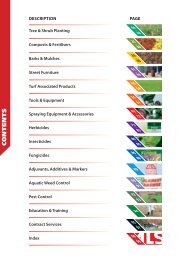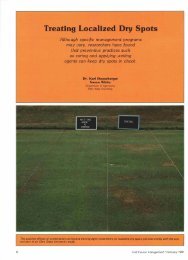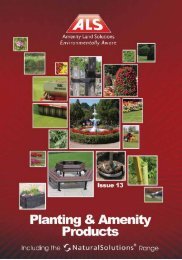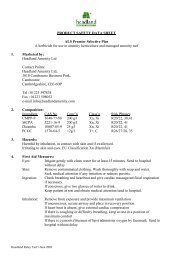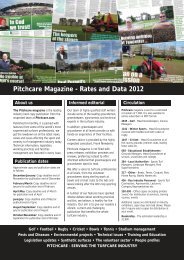these Open Championship Clubs choose to relief grind - Pitchcare
these Open Championship Clubs choose to relief grind - Pitchcare
these Open Championship Clubs choose to relief grind - Pitchcare
You also want an ePaper? Increase the reach of your titles
YUMPU automatically turns print PDFs into web optimized ePapers that Google loves.
Technical<br />
Trees represent an<br />
important resource for the<br />
environment. They provide<br />
carbon sequestration,<br />
replenish oxygen, provide<br />
habitat for vertebrates and<br />
invertebrates and, when<br />
trees die, they can be<br />
utilised for various<br />
products. In the early<br />
days, golf balls were made<br />
from the Gutta-percha<br />
trees (Eucommia<br />
ulmoides), which was used<br />
<strong>to</strong> make the ‘guttie’ golf<br />
ball.<br />
By Joe McConville,<br />
Arboricultural Association,<br />
Irish Branch<br />
As with all resources, trees need <strong>to</strong><br />
be managed. Young trees need <strong>to</strong><br />
be tended and protected from<br />
pests. Trees have a natural life<br />
span, and some species live<br />
longer than others, oaks will live well<br />
over 300 years, whilst cherries may only<br />
live seventy years. As trees get older they<br />
are more prone <strong>to</strong> disease. Different<br />
species will be attacked by different<br />
pathogens. The disease pathogens are<br />
often latent in the environment and, as<br />
the tree ages and loses its ability <strong>to</strong><br />
defend itself, it becomes more prone <strong>to</strong><br />
infection.<br />
Some pathogens are more aggressive<br />
and will attack vigorous trees and<br />
generally result in wide spread damage<br />
<strong>to</strong> the tree s<strong>to</strong>ck. A classic example of<br />
such a disease was Dutch Elm Disease<br />
which did so much damage in the 1970s<br />
and 1980s. The current cause for<br />
concern is Phy<strong>to</strong>phthora ramorum,<br />
described in the USA as sudden oak<br />
death syndrome. This fungus is infecting<br />
Japanese larch, but has been found on<br />
other species growing in close proximity<br />
<strong>to</strong> infected larch.<br />
Trees can play a very import role on<br />
SAFETY<br />
Management<br />
of TREES<br />
the golf course; they can be planted <strong>to</strong><br />
create pleasing surroundings for the<br />
course; planted strategically <strong>to</strong> define<br />
fairways; they can be used as markers;<br />
they can be planted <strong>to</strong> divide fairways<br />
which are vulnerable <strong>to</strong> attack from<br />
others holes.<br />
Golf courses that are built in existing<br />
parkland settings will also utilise existing<br />
mature trees as obstacles <strong>to</strong> define the<br />
golf course layout, and define the<br />
character of the course.<br />
Tree management<br />
Good tree management should be<br />
proactive; the financial requirements<br />
should be evaluated and integrated in<strong>to</strong><br />
annual operational budgets. In order <strong>to</strong><br />
evaluate the financial implications, the<br />
golf course should prepare a tree<br />
strategy. This is a document which sets<br />
out how the overall tree resource is <strong>to</strong> be<br />
managed. It provides the means for<br />
moving away from reactive crisis<br />
management <strong>to</strong> a more proactive<br />
approach. A tree strategy provides a<br />
clear rationale for ensuring that<br />
adequate resources are allocated on an<br />
ongoing basis.<br />
Sinking branch






